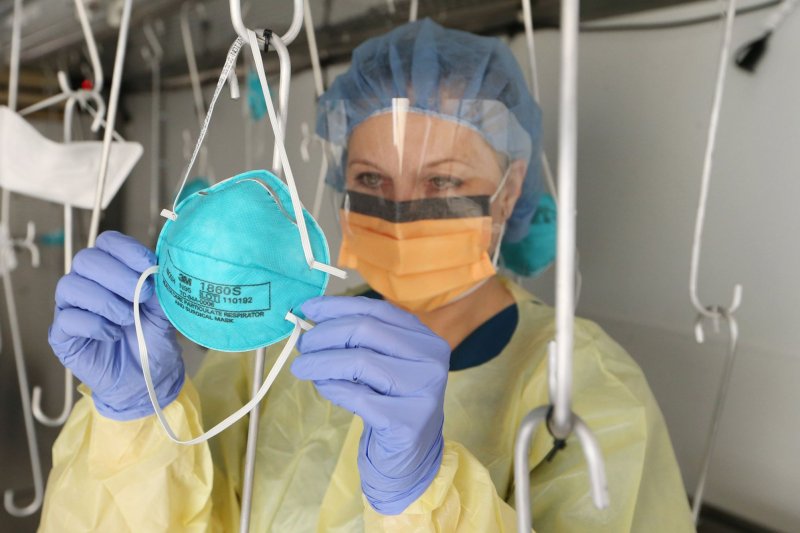APRIL 28, 2020 By Dennis Thompson, HealthDay News

Wendy Gould, R.N., inspects N95 masks that have been sanitized with UV light in a special trailer at Saint Louis University Hospital in St. Louis on Thursday. Photo by Bill Greenblatt/UPI | License Photo
Supplies of personal protective equipment remain scarce across the United States, especially the N95 respirator masks that health care workers use to protect themselves from the new coronavirus.
To help extend the useful life of available equipment, researchers and hospitals are turning to a long-known, if little-used, means of disinfection -- ultraviolet radiation.
"It's generally well known that UV-C radiation kills microbes," said Bob Karlicek Jr., director of the Center for Lighting Enabled Systems and Applications at Rensselaer Polytechnic Institute in Troy, N.Y. "What's not known is the specific quantities of UV-C radiation that is required to fully disinfect complex equipment like N95 masks, because you have to get the light to the inside of the mask."
Karlicek led a team that created a UV-C system designed to disinfect N95 masks. It's being tested at Mount Sinai Hospital in New York City.
President Donald Trump was ridiculed last week after publicly speculating that UV light could be used to treat COVID-19 infection inside the human body.
"Supposing we hit the body with a tremendous -- whether it's ultraviolet or just very powerful light -- and I think you said that hasn't been checked, but you're going to test it," Trump said at a media briefing. "And then I said, supposing you brought the light inside the body, which you can do either through the skin or in some other way, and I think you said you're going to test that, too. Sounds interesting."
Experts quickly came forward to note that UV light can be harmful to humans, and that it would be impossible for ultraviolet rays to reach deep within the body to kill coronavirus in the lungs and other organs.
That's also part of the problem with using UV light to disinfect protective gear like masks, gowns and gloves, Karlicek said.
UV light disinfects by breaking down the genetic structure of coronaviruses and other microbes, he said. The virus either dies or is rendered incapable of replicating.
But that means the ultraviolet rays must directly strike the virus -- meaning every square inch of the equipment must be exposed to UV light to be properly disinfected. Any part that falls within a shadow might still carry active coronavirus, Karlicek said.
The UV rays must also be very powerful. Mere sunlight alone will not kill the coronavirus, experts say.
The Rensselaer team's solution is a conveyor system that runs N95 masks through a battery of mercury UV lights.
"That allows us to have a vertical arrangement of UV-C mercury lamps and then suspend the masks carefully on a moving framework that would go in between the lamps, so you could simultaneously irradiate masks from both sides," Karlicek said.
The system stands about 8-feet tall and about 8-feet long. The masks are hung on a series of hooks, and the speed of the conveyor belt determines how much radiation the masks receive.
Mount Sinai doctors are testing the system to figure out the exact level of UV exposure needed to fully disinfect the masks, Karlicek said.
"There's no doubt we'll be able to deactivate the virus at the right dose," he said. "The question is how many uses can we get? Does the UV light damage the straps that hold the mask on the face? These are things that need to be worked out."
Other groups also are trying to develop similar solutions. For example, a team at the University of California, Santa Barbara, is working on a system that would use LED lights to sterilize protective gear with UV-C radiation.
"Anything we can do to extend the life of N95 masks in particular -- those are in relatively short supply pretty much everywhere -- that's certainly something I would like to see developed," said Dr. Matthew Heinz, a hospitalist and internist with Tucson Medical Center in Arizona.
"Of course, we have to take proper precautions and make sure we are adequately sterilizing the personal protective equipment," he added.
Karlicek's team assembled its prototype for about $10,000, but he warned that supply issues would hamper efforts to make more light-disinfecting machines.
"One of the biggest challenges we had in building the system was finding a supply of mercury lamps that were commercially available now, as opposed to being backordered for five or six weeks," Karlicek said.
Similar devices -- including wands, boxes and bags -- are already available for disinfecting at home using UV light, he noted.
"People are selling UV-C disinfection systems for the home, in particular UV-C wands you can wave over surfaces," Karlicek said, adding he doesn't consider them a good idea.
"You have no idea how much UV-C light you're getting from one of these wands, and you have no idea how to use it to get an appropriate dose," he said of home users. "In order to disinfect well, you really need a good amount of UV-C light."
These devices also can be hazardous to people. While UV-C light cannot penetrate the skin, it is bright enough to damage the eyes, Karlicek said.
More information
The U.S. Centers for Disease Control and Prevention has more about ultraviolet light.
Copyright 2020 HealthDay. All rights reserved.

No comments:
Post a Comment